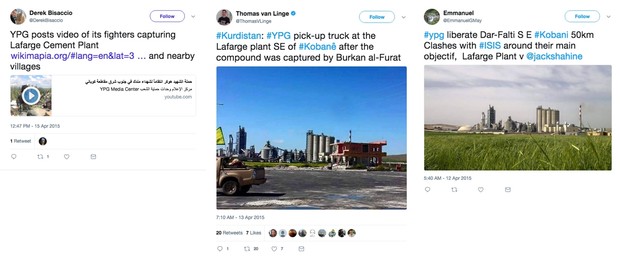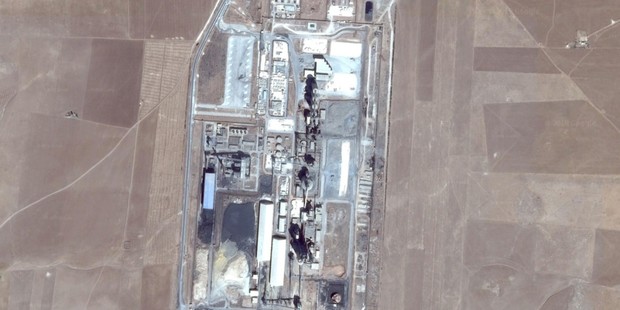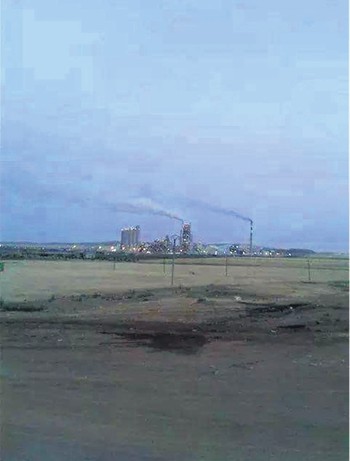© Turkuvaz Haberleşme ve Yayıncılık 2024
The year 2011 marked the beginning of a civil war, the echoes and repercussions of which keep snowballing around the globe with the military inclusion of Turkey, Russia, Iran, Israel, the U.S. and other coalition forces. But that was not and is not the only way of changing the game's course in Syria. The way of "doing business" for the sake of "business" reveals the influence of economic actors on a battlefield as in the case of French cement giant Lafarge, which was accused by French authorities of financing and bribing "armed groups" in Syria during its operations from 2012 to 2014 with an amount of $15 million. While company officials were charged with financing Daesh terrorists, and the plant reportedly ceased production in 2014, there are still a couple of questions that French politicians, the judiciary, Lafarge authorities and the U.S.-led coalition forces must answer. Because the cement factory in Syria was used as an infrastructural resource base by armed groups from 2012 to 2014 and recaptured by PKK's Syria affiliate the People's Protection Units (YPG) in February 2015, the secrecy haunting the current status continues to raise questions regarding Turkey's security concerns as the area is now controlled by the YPG. Accordingly, the question to be asked remains: Who or which actors have supplied and continue to supply cement for the construction of tunnels, towers and trenches in Afrin, which are used as military bases for the YPG?
Lafarge's deal with armed groups in Syria
In June 2016, Le Monde reported the French cement giant Lafarge's dealings with Daesh, which took control of the area, al-Jalabiya, a town located close to Ayn al-Arab, by its Kurdish name of Kobani, where the company's plant is located. Following the release of the Le Monde report in the summer of 2016, members of the French non-governmental organization Sherpa, seeking to protect the rights of those who are oppressed by economic crimes, and the European Center for Constitutional and Human Rights (ECCHR) filed a complaint in November together with former employees of the factory. French prosecutors started an investigation, and in December 2017, six former senior directors of Lafarge, which became Lafarge-Holcim after merging with the Swiss Holcim in 2015, as well as its Syrian subsidiary were charged with financing terrorism. "Lafarge kept running its cement factory plant in northeast Syria until 2014 despite the region being conflict-ridden and controlled by various armed and terrorist groups," a ECCHR release stated.Lafarge Syria's former director Christian Herrault claimed that Eric Chevallier, France's former ambassador to Syria and current ambassador to Qatar, knew about the cement producer's payments to armed groups. French investigators questioned Herrault in the presence of Chevallier, according to a source quoted by the Agence France-Presse (AFP). Herrault said he had met several times with Chevallier, who "knew about the shakedown," saying, "'You should stay, these problems won't last long." Chevallier told the investigating judges that, "He did not remember these meetings," the source said.
A diplomatic memo obtained from September 2014 acknowledges that Lafarge was at the mercy of the "balancing act between the Damas [Assad] regime, Kurdish forces and the Islamic State," though it notes that the cement factory's boss claimed it had "paid nothing" to Daesh, wrote AFP.
The plant in Jalabiya was acquired by Lafarge in 2007 from the Egyptian cement company Orascom, and production started in 2010 at a volume between 2.5 and 3 million tons, which was a very profitable business at a time when the escalating conflicts in 2011 led to a fall in cement production and an explosion in cement prices as other similar facilities shut down one by one.
In an environment of war, Lafarge insisting on keeping operations at the company's Jalabiya plant, which was first protected by Syrian regime forces. However, a former automation engineer who preferred to remain anonymous for security reasons told Daily Sabah that in the summer of 2012 the YPG controlled the area, and the plant's security was in the hands of YPG forces. He noted that he worked at the plant until Daesh forces took over the factory in September 2014. "But before Daesh came to the area, the checkpoints and the factory were controlled by Kurdish militant group YPG," the former Lafarge engineer said.
The same confirmation was also reported in the Le Monde article dated June 13, 2014. The French daily's resources indicated that the security of the Lafarge plant was provided by the YPG, the armed wing of the Democratic Union Party (PYD). But when the situation deteriorated and control of the Kurdish armed groups declined, Daesh militants started to seize checkpoints in the area and gradually took control of nearby cities as of the spring of 2013.
Raqqa, which is located 90 kilometers away from the factory, was captured by Daesh in June 2013, and the city of Manbij, which is 65 kilometers from the factory, where most of the factory's employees were based, fell to Daesh in March 2014.
Reports have put forward that Lafarge corroborated with both terror groups the YPG and Daesh, which have posed and continue to pose great danger to Turkey's security.
During the rising conflicts between the two groups, the factory management persistently continued operations despite the warnings of the employees. The former employee said, "We had told the employers – how many times I do not recall – to stop production, but they did not listen to us" because the company wanted to make profit at a time when cement prices increased and at a time of immense destruction and reconstruction. He pointed out that there was no other actor to supply materials. But for the risk manager of the plant, Jacob Waerness, who spoke to the Financial Times, it was the livelihoods of local employees and their extended families. "Local employees and their extended families depended on the salaries they received," but asked: "Can you run a business in a chaotic region where nobody follows the rules – and still follow the rules yourself?" Waerness said.
When Daily Sabah contacted Lafarge officials, asking them why the company kept operating the site, no answer related to the question was provided. Yet, the company said: "At times different armed political factions controlled, or sought to control, the areas around the plant. The environment around the plant continued to deteriorate leading to the evacuation of the site in September 2014," without further disclosure of the current state of the site.
Although other foreign companies, including energy firms like Shell and Suncor, abandoned Syria or sold their plants, Lafarge preferred to stay. A Turkish conglomerate, Güriş, also shut down its two cement factories, one in Raqqa and one in al-Hasakah, when the deterioration in the region began.
Speaking to Daily Sabah, Güriş authorities confirmed that they shut down the plant in al-Hasakah in 2011 when the Syria crisis escalated in the area and that the company did not allow any personnel, either local or foreign and wards, to be present at the plant. The factory in Raqqa, starting operations in 2009, stopped production in 2011, Güriş said.
"From 2011 to 2014, the factory was raided by armed groups that destroyed and stole some of the materials," the authorities said and added that in 2016 "certain armed groups" seized control of the plant without any prior notice to Güriş authorities who filed a criminal complaint at the Suruç Chief Public Prosecutor's Office, while asking the Suruç Municipality and the Suruç General Directorate of Security to annul any permit of passage filed in the name of Güriş.
According to reports by the Financial Times, Firas Tlass, a Syrian business tycoon who sold the plant to Lafarge but retained a one percent stake in the company and later fled the country due to opposition with the Assad regime, continued to work on behalf of Lafarge by facilitating payments to these various armed groups.
The Financial Times wrote, "According to militant groups in the area, he paid the YPG up to $100,000 a month in protection money. But the Lafarge payments to the YPG have not been prosecuted since the terror group is not listed on the U.S. or European sanctions lists and continued to receive military support from the U.S. and coalition forces.
Meanwhile, U.S. Director of National Intelligence Dan Coats said Tuesday the YPG is the Syrian militia of the PKK terrorist group in a report titled "Worldwide Threat Assessments of the U.S. Intelligence Community." Assessing the situation in Syria, Coats acknowledged the link between the YPG and the PKK, which is designated as a terrorist organization by Turkey, the U.S. and EU.
What's happening in Lafarge's Syria plant ?
In February 2015, the course of events in Jalabiya was twisted by U.S.-led coalition forces that supported the YPG, which recaptured the plant and its neighboring villages. According to numerous reports by wires and newspapers, YPG forces also announced the seizure of the Lafarge plant on social media accounts and released a video on YouTube.
But why such a ferocious fight over a plant? It was the largest Lafarge investment in the region, and it could produce 3 million tons of cement. The plant in Jalabiya included dangerous chemicals like hydrazine to use in explosives, which were reportedly stolen by Daesh, who carried out 10 attacks from 2015 to 2017 that claimed the lives of more than 300 people. Most importantly, cement factories are essential for the economy as they are essential for construction, in the Syrian case, for reconstruction. In an environment of fighting armed groups, a plant to supply the material with a developed structure is of high strategic importance.
The question to ask now: What happened to the plant after the YPG seized it? A number of reports and satellite images demonstrated that the U.S.-led coalition forces set up a military base on the plant's premises. Since the plant is conveniently located between Raqqa and Manbij, two cities that were captured from Daesh by the YPG – with the immense military support of the U.S. – and are now controlled by U.S.-trained and supported YPG.

Tweets announcing the capture of Lafarge Syria plant.
In June 2016, Le Monde published a report confirming the establishment of a military base by American, British and French forces, while the YPG told the local people not to approach the factory since it was a military zone.
"The YPG occupies this area, but there are also Americans and strangers. We see them come and go, go out and return, go to the front. They have cars different from those of the YPG. These are Toyota pickups like those of peshmerga. Some are equipped with machine guns. When they go out, they are sometimes armed, sometimes not. They can go out in a convoy or alone," a local merchant told Le Monde.
A photographer from AFP also reportedly saw American soldiers with state-of-the-art military equipment and wearing YPG emblems on their uniforms. According to a Syrian professor who spoke to the French newspaper, the appropriation of the plant by U.S.-led Western forces was settled between the Kurds, French diplomats and Lafarge.
After the release of a satellite image in June 2016 that depicts U.S. installed helipads and helicopters belonging to the U.S. army, like military transport aircraft Boeing CH-4 Chinook, Bell Boeing V-22 Osprey and assault aircraft AH-64 Apache. Other satellite images of the plant were also discovered but these images did not picture a military-base like structure at the plant.

Recent satellite images show that the plant is no longer used as a military base.
In addition to two transfer helicopters, the Lafarge plant's side had a great number of trucks as well as solid energy and other infrastructure materials that "apparently" survived Daesh violence. Moreover, geo-tagged images of the plant, which appear on Google and are dated May 2016 and January 2018, show the factory in operation with smoking chimneys.
Upon observing the cloud of uncertainty of the plant and the construction of cement tunnels and towers in northern Syria by the YPG, Daily Sabah contacted an Idlib-based journalist, speaking on the condition of anonymity, who said he went to the town of Jinderes and the village of Deir Bellut in western Afrin around two years ago. The journalist emphatically confirmed that the YPG started the construction of the tunnels and towers in Afrin two years ago as he witnessed the building process in which an "enormous amount of cement" was used.

This whole situation again begs the question: Where did the YPG militia receive the cement while building these huge tunnels, hundreds of kilometers, along the Turkish border?
When Daily Sabah contacted a local merchant in the area who very well knows all the actors, he explicitly said that the Lafarge plant currently operates under the control of the YPG, which Turkey recognizes as a terror group threatening its national security.
The merchant said, "The Lafarge plant currently runs production. There are a couple of French people working at the site as supervisors, and local people are employed in the production process." Other local people and former Lafarge employee engineer also affirmed that the area is now controlled by PYD's armed wing the YPG.
Daily Sabah, indeed, has contacted a Kurdish translator providing interpreting services for the French and the YPG in the area. But the translator immediately refused to talk about the subject.
Turkish and Free Syrian Army (FSA) forces uncovered a terrorist PKK/YPG tunnel network four meters (13 feet) below a liberated village in Afrin in northwestern Syria.
Filmed by Anadolu Agency, the tunnel network was apparently used by the terrorist group as shelter against jet strikes and other heavy artillery fire amid Turkey's counter-terrorist operations.
The tunnels also linked terrorist command centers with strategic points and surveillance towers, according to local sources who spoke on condition of anonymity due to security concerns. In the footage, electrical wiring and living areas can be seen in the tunnels and shelters.
Also found in the shelters were the diaries of some of terrorists, written in Turkish and Kurdish, as well as many political documents and images of Abdullah Öcalan, the imprisoned leader of the PKK/YPG – underlining the close links between the terrorist groups. The latest images of Afrin depict tunnels and towers, deemed as obstacles decelerating the pace of Turkey's Afrin offensive, also known as Operation Olive Branch, which started Jan. 20.
French reaction to the Afrin operation
When Turkey announced the launch of this operation, France immediately called for an emergency U.N. Security Council meeting over Syria.
"If it turns out that this operation takes a turn other than to fight a potential terrorist threat to the Turkish border and becomes an invasion operation, (then) this becomes a real problem for us," French President Emmanuel Macron said in an interview with le Figaro. In the interview with the French newspaper, Macron warned Turkey that the operation in the Afrin region should not become an excuse to invade Syria and said he wanted Ankara to coordinate its action with its allies.
The French president's remarks received indignation from Ankara. Following Ankara's reaction, Macron later downplayed and said, "I note that the reaction of the Turkish foreign minister probably means that it [the Afrin offensive] is nothing more than the security of borders and that Turkey does not intend to go further than the positions it occupies today, nor stay permanently in the region."
In light of these facts and pictures, the questions raised so far require an answer from Turkey's NATO ally France, which has exercised military, political and economic influence in Syria for more than one hundred years.
The network of Lafarge's ties to armed groups and the reported settlement between Kurdish armed groups controlling Kobani, French diplomats and Lafarge executives as well as the support YPG has received and continues to receive from the U.S.-led coalition forces escalates Turkey's security concerns.
Does this network of relations – previous and present dealings, a smoking gun pointed at the operating plant and YPG towers and tunnels – pose a threat to Turkey?
